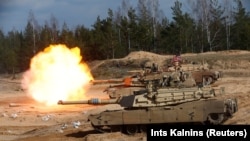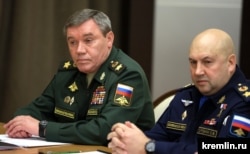In the eastern city of Bakhmut, months of relentless Russian assaults and waves of World-War-I-style infantry charges are taking their toll on exhausted Ukrainian forces. Just a few kilometers north, Ukrainian soldiers were forced to retreat west and south from the salt-mine town of Soledar after weeks of pounding by Russian troops.
Still further north, Ukraine’s effort to capitalize on a successful counteroffensive in the Kharkiv region by retaking more territory nearby appears to have stalled at what battlefield experts called the Svatove-Kreminna line, with Russian troops intensifying attacks.
And about 150 kilometers to the south, Ukraine is rushing reinforcements to defend Vuhledar and, according to some reports, push back Russian positions, which now include marine infantry from Russia’s Pacific Fleet.
After months of morale-boosting Ukrainian victories, powered in large part by Western weaponry, the tides of battle are turning yet again: For now, momentum seems to be shifting to Russia, bolstered by tens of thousands of mobilized men and thousands of prison inmates recruited and sprung from behind bars by the notorious mercenary group Wagner.
Ukrainian commanders and political leaders, including President Volodymyr Zelenskiy himself, are warning not only about the difficult conditions that Ukrainian troops are fighting under in multiple locations in the Donbas. They’re also warning of an imminent new Russian offensive, which the current intensifying fighting may be a prelude to.
“They’re right now preparing for a maximum activization,” Oleksiy Danilov, the chairman of Ukraine’s National Security and Defense Council, told RFE/RL’s Ukrainian Service on January 28, referring to Russian commanders. “They want to show some sort of achievement by the anniversary” of the invasion.
“It is no secret that they are preparing for a new wave by February 24,” he said.
Whether it’s a direct prelude to a new offensive, or merely a slow-motion beginning to one under way, the intensifying fighting on the Donbas is the latest phase in the Russian invasion, now in its 12th month.
'The Situation Has Changed Dramatically In Bakhmut'
In the initial phase, Russian forces attacked Ukraine from the north, south, and east, succeeding in capturing territory in the south, but failing in their primary objective: seizing Kyiv, toppling the government, and cowing the Ukrainian military into surrender.
In phase two, Russian forces repositioned to the Donbas, and focused efforts on taking the Luhansk cities of Syevyerodonetsk and Lysychansk over the summer. They also captured the Sea of Azov port of Mariupol after a scorched-earth three-month siege.
Ukrainian forces stunned many Western experts in September, October, and November, with a pair of counteroffensives that pushed Russian forces out of the northern Kharkiv region and led to the recapture of Kherson – the only regional capital Russian forces had taken since February 24, 2022 -- in the south.
Those Russian failures, which were accompanied by repeated shuffling of commanders, led to President Vladimir Putin’s mobilization order in September, to bring up to 300,000 Russian men into the battle.
Known colloquially as “mobiki,” those mobilized soldiers are showing up in the Donbas and elsewhere in sizable numbers now, military and intelligence experts said.
The failures have also been accompanied by a rise in the profile, and clout, of Wagner, a notorious mercenary paramilitary group. Its founder, wealthy St. Petersburg businessman Yevgeny Prigozhin with close Kremlin ties, bolstered Wagner’s ranks with thousands of prison inmates. U.S. officials have said Wagner has recruited up to 50,000 convicts to fight in Ukraine.
Those former inmates have been used in months of relentless assaults on Bakhmut, with Ukrainian soldiers reporting waves of soldiers attacking positions, and in many cases, being mowed down.
"The situation has changed dramatically in Bakhmut,” one Ukrainian soldier, identified by the alias Agronomist, said in a post published by Ukraine’s Joint Force Task Force. “When we came here, we also fought with ordinary [regular] Russian military, not” professionals or special force units.
“Recently, Wagner fighters and the GRU have appeared in our sector,” the soldier said, referring to the Russian military intelligence agency. “They are doing a pretty good job and have been fighting for not the first year. It's quite difficult to fight them.”
Indeed, conditions were worsening in Bakhmut for Ukrainian units, Konrad Muzyka, a Poland-based defense analyst, said.
“The overall situation in the Bakhmut area is deteriorating for Ukrainians, mainly because [the] Russians fire control the main supply roads leading to the city,” he wrote in an analysis on January 31. “All but one [of the] ground lines of communication leading to Bakhmut are under Russian fire control”— meaning exposed to artillery, rocket, or tank fire.
In its daily assessment on February 1, the Institute for the Study of War said Wagner and GRU units were bringing in more elite troops to add to the “human wave attacks” in Bakhmut.
“These techniques, which are likely helping reinvigorate the stalled Russian advances in and around Bakhmut, are not likely scalable to support larger offensive operations” the U.S.-based think tank said.
Amid reports that Ukrainian supply, and escape, routes were narrowing to just a road to the northwest, Colonel Serhiy Cherevatiy, а spokesman for Ukraine’s Eastern Command, said January 31 that Bakhmut was still being supplied with food, ammunition, and weapons.
Still, other front-line officers repeated the observations that the fighting around the town was intense, and hinted at the possibility that Ukrainian commanders might order a retreat.
“You have to understand that scenarios such as withdrawing temporarily from some territory should always be considered,” Major Maksym Zhoryn, of Ukraine’s 3rd Assault Brigade, told Current Time.
“We’ll fulfill whatever orders are issued,” Zhoryn said.
In Soledar, a town about 18 kilometers north of Bakhmut, straddling an important highway northeast, toward Lysychansk and Syevyerodonetsk, Ukrainian commanders ordered what they said was a controlled retreat earlier this month after weeks of similarly intense assaults spearheaded by Wagner-recruited prison inmates.
“Russian forces may feasibly seek to use gains north of Soledar as a launching pad for northeastward attacks towards Syversk,” the Institute for the Study of War said. That would “support enveloping the Ukrainian defensive position on the west side of the Siverskiy Donets River.”
In Vuhledar, about 150 kilometers to the south of Bakhmut, Ukrainian troops reported an increased tempo in Russian attacks, led by marine infantry units from the Russian Pacific Fleet. Ukrainian commanders said their positions had been reinforced with more troops, and claimed that the marine units had suffered major losses.
Rushed Offensives?
For now, the main question is: What comes next?
Ukraine’s Western allies have continued a firehose of weaponry and materiel for Kyiv, most notably the recent decisions to supply powerful new battle tanks and armored vehicles: M1 Abrams, Leopard 2s, Challengers, Marders, Bradleys, and AMX-10s.
Many Western experts say the tanks, in particular, could provide Ukraine with an advantage over Russia’s older tank workhorse – the T-72. And Ukrainian officials fear stalemate could turn into attrition, which favors Russia’s bigger economy and bigger population. That means Kyiv is eager to show its ability to make quick battlefield gains and regain more territory, in case Western patience runs thin and purses are tightened.
But, if the repeated warnings of Ukrainian officials are correct, Russian commanders are also eager prove to the Kremlin that they are still capable of battlefield victory.
“The Kremlin wants something more offensive, more forward, more territory. Right now, the pieces of evidence that would support that thesis; there are reports in the last couple days that things are picking up now,” Dara Massicot, a military researcher at the RAND Corporation, a U.S.-based think tank, said in a podcast earlier this week. “There are rumors that all of the Russians that were being trained in Belarus are now starting to decamp and maybe committed somewhere else.”
“So I definitely think there is a potential from Russia's perspective in the near term -- it benefits them to try to make progress before new capabilities are introduced,” she said.
Earlier this month, Putin again shuffled the top commanders in charge of the Ukraine operation, demoting General Sergei Surovikin after just three months, and giving the command back to the chief of the general staff, General Valery Gerasimov, who was in charge at the outset of the invasion.
“I think with the shuffling in command, I think that the chances the Russians try to rush and do an offensive before they're ready [have] gone up,” Massicot said.












